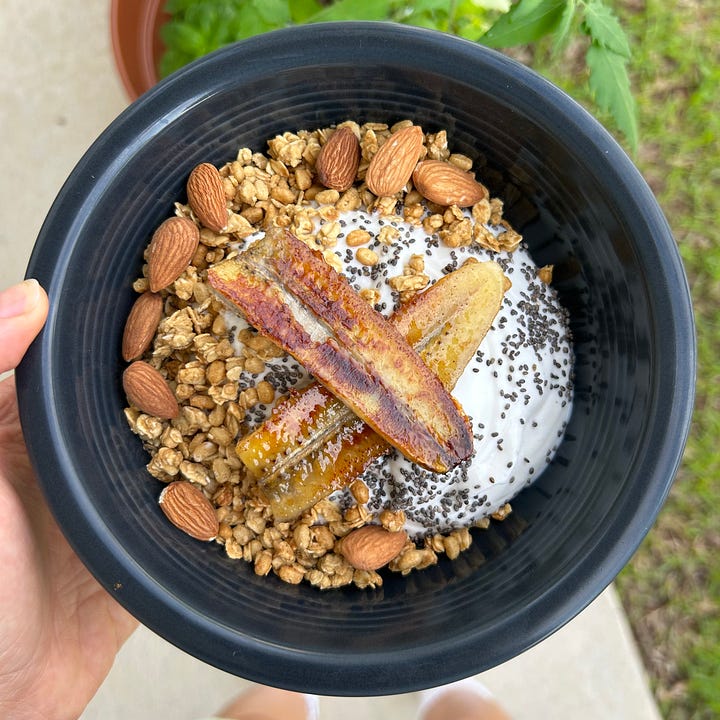Hi friends,
Something about spring—maybe it’s Spring cleaning, taken a little too far—always seems to bring “detoxing” back into the zeitgeist. (Assuming it ever left.)
As a dietitian, I hear about detoxes all the time. Clients ask if they should do one, confess they just did one, or admit they’re thinking about “a little cleanse” to bounce back from a weekend of “going off the rails.”
Call it what you want - a reset, refresh, cleanse, jumpstart, or plain old detox, we’re usually chasing the same thing: a feeling.✨
I’ve found that most people aren’t truly concerned about their liver enzymes. What they’re actually seeking is...
Desire for a fresh start (“I’ve been eating like crap and need a reset”)
Quick results (often weight loss, clearer skin, less bloating)
Control and structure (“If I follow this plan, I’ll feel in control again”)
A need to "fix" something they feel is wrong with their body
Fear of “toxins” or “chemicals” – even if vaguely defined
Maybe you’re feeling bloated, sluggish, out of control with food, low energy, “puffy,” “inflamed,” or just all around moody. You’re not alone, but what you don’t need is a box of soups, bars, teas and potions like the internet will have you believe.
A detox diet offers a simple, sexy “solution” to complex, layered issues— what you really need is to support your body’s natural detoxification pathways.
Let’s take a moment to reframe detoxing:
A “detox” may sound appealing if you are looking for more energy, better digestion, clearer skin, or less bloating. Maybe you want to give your liver a break, “clean out” your system, or simply have someone tell you exactly what. to. do. I get it.
I want you to remember, your body already detox — every single day. But the real magic happens when you support it consistently with the basics of what it needs to work most effectively: fiber, water, sweat, and rest.
You can build daily detox routines, without taking extreme measures or feeling deprived, stressed or depleted.
Your detox organs—liver, kidneys, gut, skin, lungs, and lymphatic system—are always working behind the scenes. So instead of trying to flush them out (whatever that means), ask yourself: What can I do today to help them work better?
Science-Backed Detox Support
Now that you’re well aware I wont be setting you up for a week of crying into your bone broth, let’s look a some foundational ways to support your body’s natural (amazing!) functions. Briefly:
Liver: Cruciferous veggies (broccoli, Brussels), enough protein, B vitamins
Gut (Pooping): Soluble & insoluble fiber, water, fermented foods, movement
Kidneys: Hydration, potassium-rich foods (leafy greens, sweet potato)
Skin (Sweating): Movement/exercise, sauna if available
Lymphatic System: Walking, hydration, deep breathing, lymphatic massage, dry brushing
Mental detox: Mindful eating, social media boundaries
Sounds reasonable right? Add a cruciferous vegetable to your next meal and you’re already helping reduce free radical damage, support liver enzymes and improve the GI (poop)-level detox. Followed by a walk around the neighborhood? Moving lymph, boosting oxygen flow and improving circulation.
Detoxing for weight loss? Let’s clear that up too.
Maybe you’re still craving that hard reset, or a “detox” as a way to jumpstart weight loss…
Most “quick-fix” cleanses lead to fast weight loss by shedding water and glycogen (your body’s stored carbs), not actual body fat. Once you return to regular eating, the scale can go right back up.
Plus, extreme calorie cuts can backfire—causing muscle loss, slowing metabolism, and disrupting hunger & fullness hormones. The result? More cravings, less energy, and a higher chance of regaining the weight (and then some).
Overly restrictive plans can also leave you short on key nutrients, leaving you feeling tired or foggy. Some detoxes even mess with blood sugar, hydration, and electrolyte balance—not exactly a recipe for long-term wellness.


A better way to dial in on weight loss:
Instead of restricting, try nourishing. Focus on adding more of the good stuff.
Increase your intake of fiber-rich foods like veggies, fruit, berries, legumes, seeds, and whole grains.
Lean protein and healthy fats to get full, stay full, and fuel your body without the glucose spikes.
Daily (yes, DAILY!) movement to encourage fat burn, stimulate muscle repair, improve circulation and support your lymphatic system.
Quality sleep (NIGHTLY!) for a healthy circadian rhythm, hormone support and to help your body repair and reset for another day of great choices.
Cutting back on alcohol and ultra-processed foods to reduce inflammation, reduce blood sugar and insulin spikes, and help all your organs thrive.
Prioritize stress management — chronic stress can increase cortisol, disrupt sleep, and drive cravings. Gentle movement, breathing exercises, time in nature, and even just saying “no” more often can all help your nervous system chill out and your body feel safe to let go.
Still not seeing results? You’re not alone. Many people feel like they’re “doing everything right,” but progress stalls. Before getting frustrated, take an honest inventory: How consistent are your habits, really?
Often, it’s not about trying harder — it’s about making your healthy habits sustainable. Real progress comes from actions you can repeat — not perfectly, but regularly.
Your body doesn’t need a sudden cleanse. It needs steady support.
Still tempted to try something extreme? Ask yourself: Could I actually keep this up long term? If not, it’s probably not your solution—it’s just a short detour from building the real habits that support your health for the long haul.
I hope this was helpful to you or gave you new insights on your path. As always, feel free to let me know if there are any topics or questions you’d like me to cover! Until next time,
Haela






